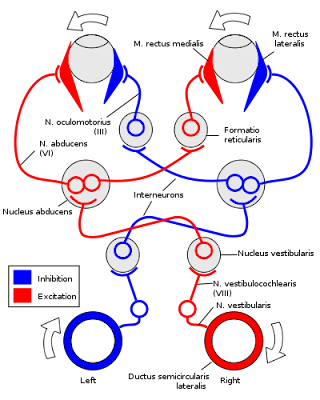Are you're like me and have a fear of math? Some of us think our brains are just incapable of solving any math problems of the least complexity. But the truth is that your brain performs wondrously complex math gymnastics while you're awake and maybe even while you sleep. You'd be amazed at how good your brain can even do calculus, while you're not even conscious of it.
I'll try to prove it if you'll play along with this simple exercise. Focus on a small dot in front of you. Here. Let me even provide the dot for you.
For those who are listening to the audio version and aren't reading or watching, just stare at a small object a couple of feet in front of you. Now keep your eyes focused on that spot and slowly move your head to the left as far as you can while still looking at the spot. Then slowly all the way to the right. Now move your head more quickly. Left to right. Up and down. Move your head in circles, keeping your focus on the dot. (If someone in the room thinks you've lost your mind, you can explain yourself later.) Now here's the point of this weird exercise: Carefully notice how your eyes are moving in relation to your head, shifting in the opposite direction in almost precise proportion to your head's location as it moves around; all so your eyes can stay focused on the intended object. Right now you're doing this voluntarily, but isn't it amazing how this reflex of coordination happens on a subconscious level practically all of your waking hours!
This process is the vestibulo-ocular reflex, or VOR. Yea, I agree. Let's just call it the VOR. Lower life forms like fish operate with a much simpler eye and body movement orientation that's nowhere as complex as our VOR. Until you started doing this little VOR experiment, I'll bet you never thought of all the intricacies involved between the muscles of both of your eyes and the retina, neurons, not just one but various regions of the brain where the VOR actions are sorted out at amazing speed, not to mention the functions of the semicircular canal of your inner ear that helps your head and body stay balanced, special receptors in your neck muscles, and I could go on and on. And, if you really think about it while doing this exercise, you'll realize that this precise coordination between your head or body movement and your eyes must involve some pretty advanced mathematics. More specifically, calculus.
Above illustration from Wikipedia. "Vestibulo-ocular reflex." I don't recommend trying to memorize it.
Calculus could be called the study of change. During VOR the brain is studying things like the rate of change in direction and speed of your head as you move it around so your brain can then compute this data and make your eyes move just right, all while ensuring you don't lose your balance and hurt yourself. The process of "neural integration" implies that meaningful mathematical integers must be computed in the brain and communicated to the eye muscles and other organs at blinding speed through an elaborate feedback loop for VOR to work correctly.
So, even though your conscious brain might have a lot of trouble working out most math problems, to the fearful point of making you avoid math like the plague, your unconscious brain and connected organs are running complex calculus equations in the background, at astonishing speed, all the time. And aren't you glad it's an unconscious process! This and so many other crucial brain functions, it seems, would literally drive us crazy if we were consciously aware of them every time they happened!
Now consciously think about this: If we had to ponder the VOR from a strictly evolutionary viewpoint, it would logically follow that somewhere way back in the evolutionary past, before we were actually homo sapiens, there had to be a state of affairs among our ancestors' biological makeup in which the neural framework that performs calculations for the VOR did not exist, right? Somewhere along the very long chain of evolution from relatively simple, single-celled life to our present human state, some particular ancestor of ours had to go from not having a calculus-performing system to having one, though, granted, it wouldn't have to carry out equations as complex as our modern subconscious. Somehow at some time, the perceptual reflexes in your biological ancestors went from operating by relatively simple physical laws to something incredibly more complex: a calculating system that almost perfectly times out and balances our eye coordination with mathematical precision. Mysteriously along the way, evolution caused mathematical operations to arise from non-math--so the thinking goes. But if this ancestral neural system were not mathematically precise at the moment it first arose from chance mutations, it's hard to see how it would have any value for survivability. How could the neural system preserve the species for further evolution? So to say this subconscious "brain calculus" of ours arose through a long chain of lucky random mutations preserved by natural selection? That just doesn't seem to add up, does it?








